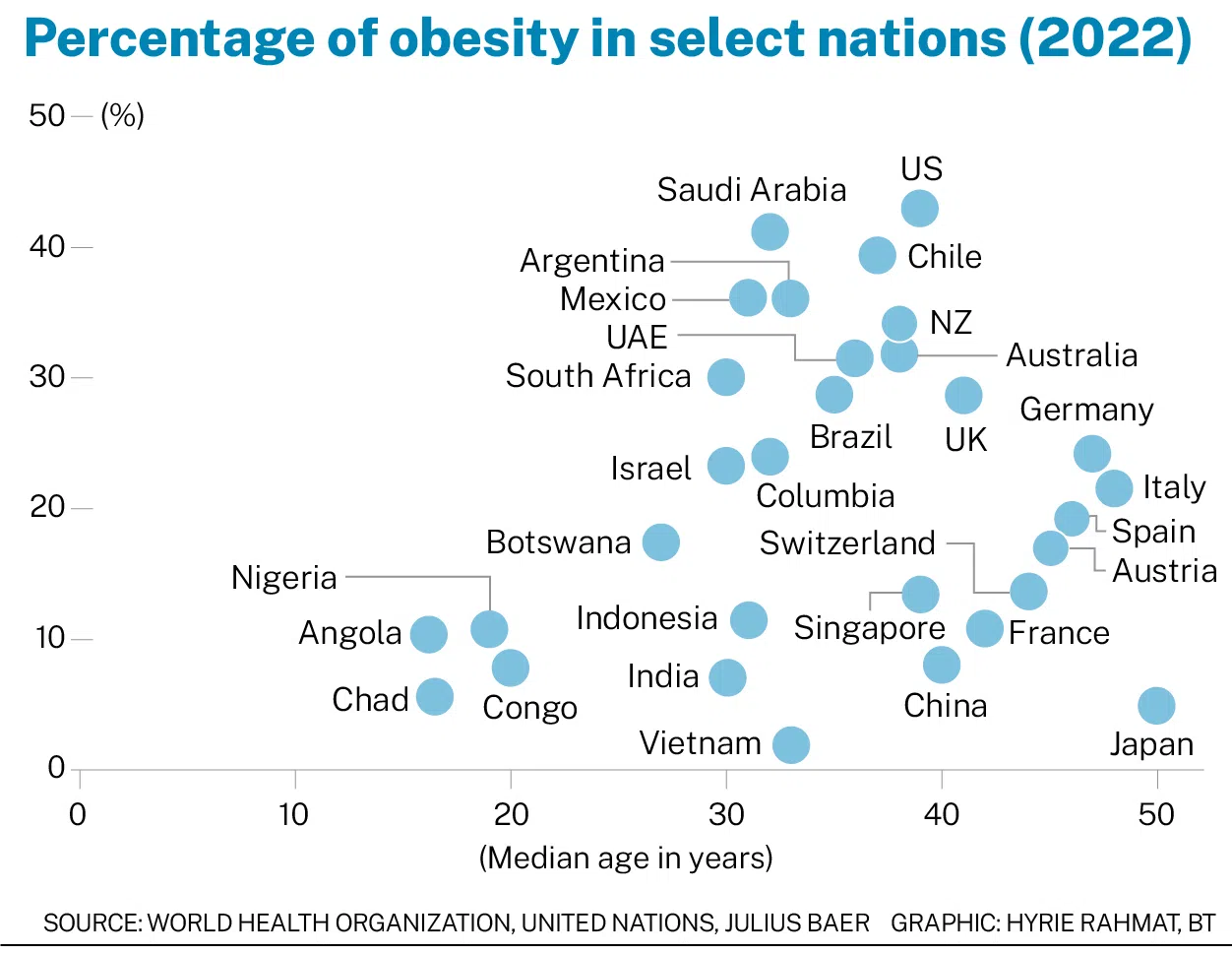Opportunities in new class of weight-loss medications
The popularity of anti-obesity therapies is also driven by a flurry of activity on social media platforms
THE recent boom in anti-obesity drugs has resuscitated discussions about the medications and their long-term impact on personal well-being and industries such as food and medical technologies (medtech).
Originally approved for diabetes, this new class of medications – called glucagon-like peptide 1 receptor agonists (GLP-1) – has grabbed international news headlines for the drugs’ ability to help people control their blood sugar and lose weight. They can also help decrease the risks of cardiovascular illnesses and strokes, and reduce scarring and inflammation from non-alcoholic fatty liver disease, a debilitating consequence of obesity.
The popularity of the therapies is also driven by a flurry of activity on social media platforms, with users documenting their transformative weight-loss experiences using GLP-1.
Eli Lilly and Novo Nordisk are the two leading companies that dominate the weight-loss market worldwide. However, the success of their drugs has also piqued the interest of other large pharmaceutical companies looking to tap into the lucrative market, which is widely expected to reach US$100 billion by 2030. Meanwhile, the broad demand has already caused world-wide shortages.
The world is getting heavier
The rapid uptake of weight-loss drugs is primarily driven by the large existing prevalence and still-rising number of new cases of obesity worldwide. According to the World Obesity Atlas 2023, which was published by the World Obesity Federation, the number of overweight people worldwide with a body mass index (BMI) of over 25 is expected to increase from 2.6 billion in 2020 to over four billion by 2035.
Perhaps even more worrisome is the fact that as an emerging trend, the world is likely to witness the steepest increase in obesity prevalence among children and adolescents. Specifically, the World Obesity Federation forecasts that the global share of obese boys in the young demographic cohort will double from 10 per cent to 20 per cent from 2020 to 2035. Mirroring the figures for boys, the statistics for girls worldwide show an increase from 8 per cent to 18 per cent. These developments have severe implications for society.
According to the World Health Organization, around five million lives are lost every year due to the development of chronic diseases (e.g. cardiovascular diseases, diabetes, cancers, chronic respiratory diseases, digestive disorders) caused by a higher-than-optimal BMI value.
To illustrate, since China began its economic reform in 1978, the average disposable income of households has reached 33,000 yuan (S$6,152) in 2020, up from 171 yuan in 1978. The growth in discretionary income over the past few decades has led to the rise of a richer middle class, and subsequently a shift in dietary habits across the country. Given that the national share of overweight and obese individuals in China is expected to grow from 50 per cent in 2020 to 60 per cent by 2040, the economic impact of the health conditions in the East-Asian nation is expected to overtake that of the US, surpassing US$2 trillion.
Compelling investment case
The widely held notion that body fat is purely a result of excess energy has led to the common advice that one should simply “eat less and move more” to lose weight. However, the mantra has proven unhelpful for many people struggling with chronic weight problems and related medical complications.

This is because the strategy primarily focuses on self-resolution and a strong sense of self-restraint to achieve a deficit in calorie intake, while ignoring the influence of genetics, mindset, and social norms on exercise and food choices. Granted, there are holistic approaches that could help individuals to keep their weight in check, including adhering to a well-balanced diet, adopting regular exercise, and managing stress and anxiety level, some patients may still need initial help to change their situation. The boom in popularity of weight-loss drugs in combination with lifestyle changes offers a potential turning point in the fight against this mounting health threat and economic burden.
GLP-1 drugs are no panacea. These drugs cannot stop the obesity epidemic alone. However, they can provide a critical first step for patients to change the progression of their health condition.
From the drug pipeline perspective, the new weight-loss drug molecules in various stages of clinical development promise to offer differentiated, synergistic benefits to this current first generation of treatments. The two key players, Eli Lilly and Novo Nordisk, are expected to significantly expand their drug capacity through capital expenditure of around US$30 billion by 2026.
Despite their investments, we will continue to see significant supply shortages globally in the next three years and most likely beyond, as additional competitors will not be able to enter the market until 2028-2029. For these reasons, the prospects for the weight-loss market remain bright, not least because valuations remain compelling.
The rise of obesity drugs should not exert an adverse impact on the companies involved in the fields of nutrition, physical activity, mental health, and medtech, given the rising incidence of chronic diseases and age-related health conditions as a result of a rapidly ageing society, changing lifestyle, and increased stress from the demands of everyday life. Growing awareness of the importance of modifying our lifestyle through proper nutrition and regular exercise remains key to a healthier life.
Although the global weight-loss drug market is still in its infancy, it should continue to see significant revenue growth for years to come.
The writer is next generation research analyst, Julius Baer
Decoding Asia newsletter: your guide to navigating Asia in a new global order. Delivered to your inbox. Free.
Copyright SPH Media. All rights reserved.


